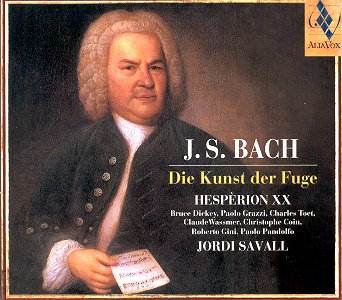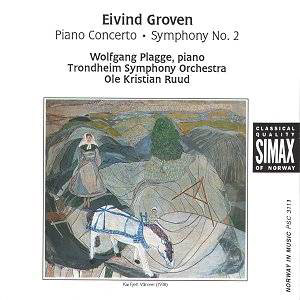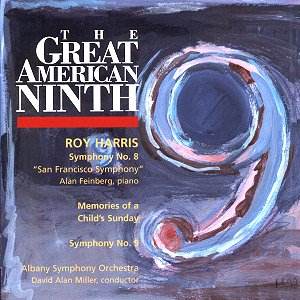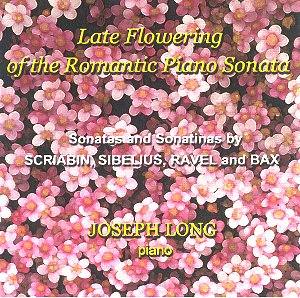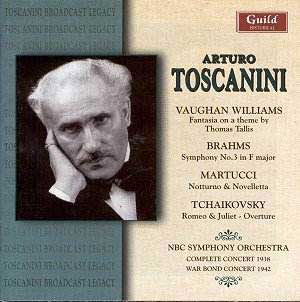 Composer: Arturo Toscanini
Composer: Arturo Toscanini
Works: Ralph Vaughan Williams – Fantasia on a Theme of Thomas Tallis; Johannes Brahms – Symphony No. 3 in F Op. 90; Giuseppe Martucci – Notturno, Novelletta; Pyotr Ilyich Tchaikovsky – Fantasy Overture “Romeo & Juliet”; J.S. Bach – Air from Suite No. 3 in D; Franz Joseph Haydn – Symphony No. 101 in D “The Clock”
Performers: NBC Symphony Orchestra, Arturo Toscanini (conductor)
Recording: CD1 recorded 15th October 1938; CD2 recorded 4th April 1942
Label: Guild GHCD 2211/12
Arturo Toscanini remains a towering figure in the realm of conducting, characterized by his intense interpretative style and profound understanding of the scores he championed. This double CD set showcases performances that encapsulate his broad musical sympathies, featuring works that range from the pastoral beauty of Vaughan Williams to the robust architecture of Brahms. The recordings, made over a span of four years, not only highlight Toscanini’s interpretative prowess but also serve as historical snapshots of a pivotal era in orchestral music.
The first disc commences with Vaughan Williams’ “Fantasia on a Theme of Thomas Tallis,” a piece that, while often associated with a more languid, English pastoral approach, is invigorated under Toscanini’s baton. His interpretation reveals a remarkable tension between serenity and intensity, invoking the ethereal qualities of the strings while maintaining a dynamic forward momentum. The ensemble’s playing is exemplary, showcasing both the power of the full orchestra and the delicate nuances of individual string solos. One cannot overlook the slight radio interference that mars the pristine sound, nor the premature audience applause that interrupts the meditative conclusion. Nonetheless, Toscanini’s ability to conjure the unique spirit of Vaughan Williams’ work is undeniable, with climaxes built to an electrifying intensity that feels both organic and inevitable.
Following this, the Brahms Third Symphony unfolds with a clarity and energy that epitomizes Toscanini’s interpretative style. Notably, the first movement exudes a sense of buoyancy, capturing Brahms’ optimistic outlook through a tight ensemble that recalls the intimacy of chamber music. Toscanini’s interpretative choices, such as the subtle reduction of tone at the opening of the second track, might challenge conventional readings, yet they illustrate his instinctive empathy with Brahms’ harmonic language. The slow movement, unusually brisk, retains a natural flow, benefiting from exquisite woodwind contributions. The coda, marked by an expressive relaxation of tempo, reveals the full splendor of Brahms’ melodic invention, proving Toscanini’s deep understanding of the symphonic form. Although the recording exhibits a slight imbalance favoring the upper registers, the overall sound fidelity captures the essence of the performance, allowing the listener to appreciate the intricate interplay of orchestral voices.
CD2 presents a more eclectic array of works, beginning with Martucci’s “Notturno” and “Novelletta.” These pieces, reflective of Toscanini’s admiration for Martucci, are delivered with affectionate phrasing and remarkable orchestral cohesion, further illustrating the conductor’s dedication to showcasing lesser-known repertoire. The engineering here surpasses that of the prior disc, offering a clearer sonic picture of the orchestra’s capabilities. However, Tchaikovsky’s “Romeo and Juliet” introduces a moment of disquiet, as the percussion section grapples with the off-beat rhythms, slightly undermining the otherwise compelling performance. Yet, Toscanini’s interpretative acumen shines through, particularly in how he allows the love theme to resonate with a palpable urgency, transforming it into a driving force for the ensuing drama, a testament to his ability to navigate the emotional landscape of Tchaikovsky’s score.
The finale of the second disc, featuring Haydn’s “The Clock” Symphony, feels somewhat lackluster in comparison to the preceding works. The orchestra, while delivering the essential character of Haydn’s invention, exhibits signs of under-rehearsal, with rough edges that detract from the overall experience. The recording quality in this segment suffers as well, with pitch fluctuations and interference from other stations that disrupt the listening experience.
This collection, despite its flaws, is a valuable addition to the catalog of Toscanini’s legacy. The performances of Vaughan Williams, Brahms, and Tchaikovsky stand out, reflecting not only the conductor’s interpretative brilliance but also his commitment to the orchestral tradition. The historical context of these recordings adds depth to the listening experience, allowing us to appreciate the evolution of orchestral performance in the early 20th century. For those seeking to understand the breadth of Toscanini’s artistry, this set offers an engaging and enlightening journey through some of the repertoire’s most treasured works.
